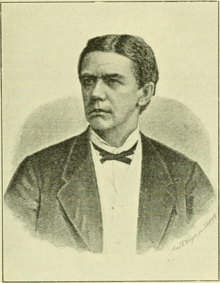Theodor Kjerulf

Theodor Kjerulf (30 March 1825 – 25 October 1888) was a Norwegian geologist and poet.
He was born in Christiania, and was the brother of Halfdan Kjerulf.[1] He was educated in the Royal Frederick University and subsequently studied at Heidelberg, working in Robert Bunsen's laboratory. In 1858, he was hired as a lecturer at the Royal Frederick University. In the same year, he became director of the Norwegian Geological Survey, which he had been instrumental in establishing. In 1866 he was promoted to professor of geology.[1]
His contributions to the geology of Norway were numerous and important,[1] especially concerning the southern portion of the country, the structure and relations of the Archaean and Palaeozoic rocks, and the glacial phenomena. His principal works were Das Christiania Silurbecken (1855) and Udsigt over det sydlige Norges Geologi (1879).[1] Kjerulf was a member of the Royal Swedish Academy of Sciences from 1869.
He also published three collections of poetry; in 1848, 1854 and 1866.[1] From 1856 to 1857 he was the chairman of the Norwegian Polytechnic Society.[2]
Kjerulf was brother-in-law to Norwegian artist Hans Gude.[3] He died in Kristiania on 25 October 1888.
References
 This article incorporates text from a publication now in the public domain: Chisholm, Hugh, ed. (1911). Encyclopædia Britannica (11th ed.). Cambridge University Press.
This article incorporates text from a publication now in the public domain: Chisholm, Hugh, ed. (1911). Encyclopædia Britannica (11th ed.). Cambridge University Press.
- ↑ 1.0 1.1 1.2 1.3 1.4 "Kjerulf, Theodor". Store norske leksikon. Kunnskapsforlaget. 2007.
- ↑ "PFs formenn 1852 - 2004" (in Norwegian). Norwegian Polytechnic Society. Retrieved 27 November 2009.
- ↑ Haverkamp, Frode. Hans Fredrik Gude: From National Romanticism to Realism in Landscape (in Norwegian). trans. Joan Fuglesang.
| Preceded by L. Segelcke |
Chairman of the Norwegian Polytechnic Society 1856–1857 |
Succeeded by Hartvig Caspar Christie |
|